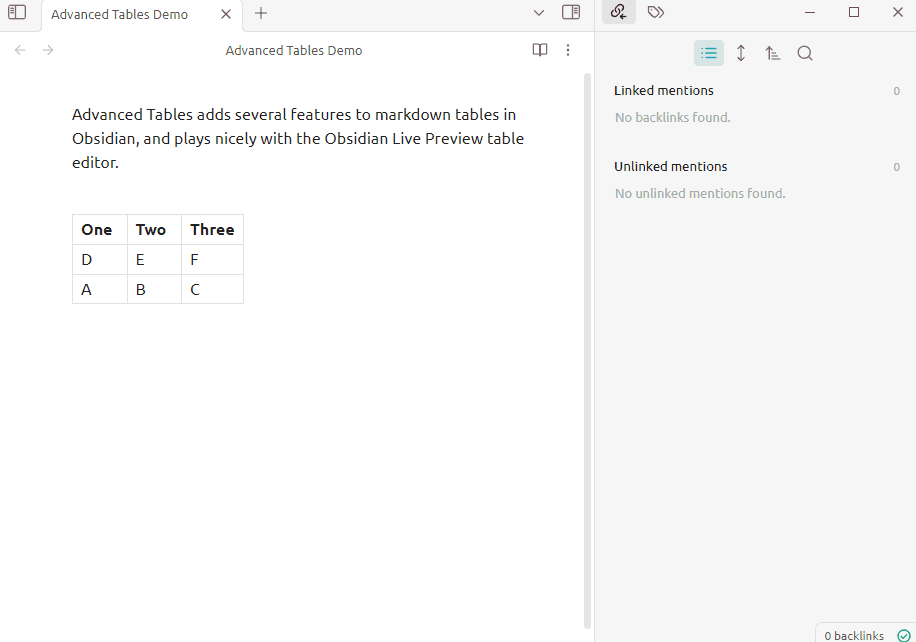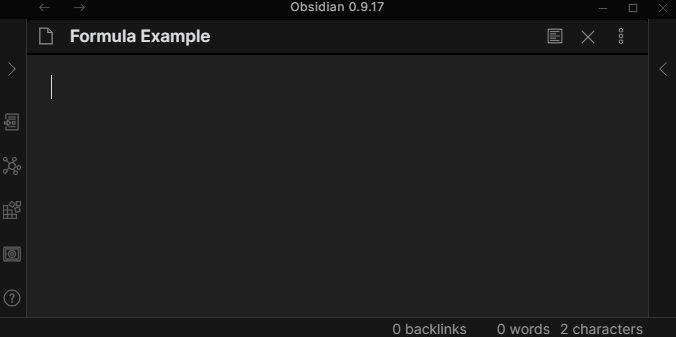 advanced-tables-obsidian
advanced-tables-obsidian
Improved table navigation, formatting, and manipulation in Obsidian.md
Top Related Projects
Integrate Git version control with automatic commit-and-sync and other advanced features in Obsidian.md
A data index and query language over Markdown files, for https://obsidian.md/.
Create markdown-backed Kanban boards in Obsidian.
Simple calendar widget for Obsidian.
A plugin to edit and view Excalidraw drawings in Obsidian
Adds admonition block-styled content to Obsidian.md
Quick Overview
Advanced Tables for Obsidian is a plugin that enhances table functionality in the Obsidian note-taking application. It provides features for creating, editing, and formatting tables with ease, improving the overall table management experience within Obsidian.
Pros
- Automatic table formatting and alignment
- Spreadsheet-like formula support for calculations within tables
- Keyboard shortcuts for efficient table navigation and editing
- CSV import and export capabilities
Cons
- Limited to use within the Obsidian ecosystem
- May have a learning curve for users unfamiliar with advanced table features
- Potential conflicts with other Obsidian plugins or themes
- Requires manual installation and updates through Obsidian's community plugins
Code Examples
As this is a plugin for Obsidian and not a standalone code library, there are no direct code examples to provide. The functionality is integrated into the Obsidian interface and is used through the application's UI and keyboard shortcuts.
Getting Started
To install and use Advanced Tables for Obsidian:
- Open Obsidian and go to Settings
- Navigate to Community Plugins and disable Safe Mode
- Click "Browse" and search for "Advanced Tables"
- Click "Install" next to the Advanced Tables plugin
- After installation, enable the plugin in the Community Plugins section
Once installed, you can start using Advanced Tables by:
- Creating a new table using the
|character to separate columns - Using Tab and Enter keys to navigate and expand the table
- Applying formulas by starting a cell with
= - Accessing additional features through the command palette (Ctrl/Cmd + P)
For more detailed instructions and features, refer to the plugin's documentation within Obsidian or on the GitHub repository.
Competitor Comparisons
Integrate Git version control with automatic commit-and-sync and other advanced features in Obsidian.md
Pros of obsidian-git
- Provides Git integration directly within Obsidian, allowing for version control and syncing
- Offers automated backup functionality with customizable intervals
- Supports pull, push, and commit operations without leaving the Obsidian interface
Cons of obsidian-git
- Requires Git to be installed on the user's system
- May have a steeper learning curve for users unfamiliar with Git
- Limited to Git-specific functionality, unlike the table-focused features of advanced-tables-obsidian
Code Comparison
While a direct code comparison isn't particularly relevant due to the different purposes of these plugins, here's a brief example of how they might be used:
obsidian-git:
// Automatically commit changes every 5 minutes
this.registerInterval(
window.setInterval(() => this.gitManager.commitAndPush(), 5 * 60 * 1000)
);
advanced-tables-obsidian:
// Format a table row
const formattedRow = this.formatRow(row, columnWidths);
Both plugins enhance Obsidian's functionality, but in different ways. obsidian-git focuses on version control and syncing, while advanced-tables-obsidian improves table editing and formatting within Obsidian notes.
A data index and query language over Markdown files, for https://obsidian.md/.
Pros of Dataview
- More powerful querying capabilities, allowing complex data extraction from notes
- Supports multiple output formats (lists, tables, tasks, etc.)
- Offers a JavaScript API for advanced customization
Cons of Dataview
- Steeper learning curve due to its query language and advanced features
- May be overkill for users who only need basic table functionality
- Requires more setup and configuration for optimal use
Code Comparison
Advanced Tables:
| Column 1 | Column 2 | Column 3 |
|----------|----------|----------|
| Data 1 | Data 2 | Data 3 |
Dataview:
TABLE column1, column2, column3
FROM "folder"
WHERE condition
SORT column1 ASC
Summary
Advanced Tables focuses on creating and managing markdown tables with ease, offering features like formatting and navigation. Dataview, on the other hand, provides a robust querying system for extracting and displaying data from notes in various formats. While Advanced Tables is simpler to use for basic table needs, Dataview offers more flexibility and power for complex data management within Obsidian.
Create markdown-backed Kanban boards in Obsidian.
Pros of Obsidian Kanban
- Provides a visual board-based task management system
- Allows for easy drag-and-drop organization of tasks
- Supports multiple lanes for different stages or categories
Cons of Obsidian Kanban
- Less suitable for structured data entry and tabular information
- May require more setup time for complex workflows
- Limited in terms of data analysis and sorting capabilities
Code Comparison
Advanced Tables Obsidian:
| Column 1 | Column 2 | Column 3 |
|----------|----------|----------|
| Data 1 | Data 2 | Data 3 |
| Data 4 | Data 5 | Data 6 |
Obsidian Kanban:
---
kanban-plugin: basic
---
## To-Do
- [ ] Task 1
- [ ] Task 2
## In Progress
- [ ] Task 3
## Done
- [x] Task 4
The Advanced Tables Obsidian plugin focuses on creating and managing structured tables within Obsidian notes, while the Obsidian Kanban plugin provides a visual board for task management. Advanced Tables is better suited for organizing data in a tabular format, whereas Obsidian Kanban excels in visualizing workflow stages and task progression.
Simple calendar widget for Obsidian.
Pros of Calendar Plugin
- Provides a visual calendar interface for managing and viewing notes
- Offers daily note creation and navigation features
- Integrates well with existing Obsidian workflows and plugins
Cons of Calendar Plugin
- Limited to calendar-specific functionality
- May not be as useful for users who don't rely heavily on date-based note organization
Code Comparison
While a direct code comparison isn't particularly relevant due to the different purposes of these plugins, we can highlight some key differences in their implementation:
Calendar Plugin:
export default class CalendarPlugin extends Plugin {
async onload() {
this.registerView(CALENDAR_VIEW_TYPE, (leaf) => new CalendarView(leaf));
// ...
}
}
Advanced Tables:
export default class AdvancedTables extends Plugin {
onload() {
this.registerEditorExtension(tablePlugin);
// ...
}
}
The Calendar Plugin focuses on creating a custom view, while Advanced Tables extends the editor functionality.
A plugin to edit and view Excalidraw drawings in Obsidian
Pros of Excalidraw Plugin
- Offers a powerful drawing and diagramming tool within Obsidian
- Supports collaborative editing and real-time syncing
- Provides a wide range of shapes, icons, and customization options
Cons of Excalidraw Plugin
- Steeper learning curve compared to Advanced Tables
- May be overkill for users who only need simple table functionality
- Requires more system resources due to its extensive features
Code Comparison
While a direct code comparison isn't particularly relevant due to the different functionalities of these plugins, we can look at how they're typically used in Obsidian:
Advanced Tables:
| Column 1 | Column 2 |
|----------|----------|
| Data 1 | Data 2 |
Excalidraw Plugin:
```excalidraw-plugin
{
"type": "excalidraw",
"version": 2,
"source": "https://excalidraw.com",
"elements": [...]
}
The Advanced Tables plugin focuses on enhancing Markdown table functionality, while the Excalidraw Plugin introduces a full-fledged drawing tool into Obsidian. The choice between them depends on whether the user needs advanced table management or complex diagramming capabilities.
Adds admonition block-styled content to Obsidian.md
Pros of Admonitions
- Offers a wider range of customization options for callouts and admonitions
- Provides more visual styling choices, including icons and color schemes
- Supports nested admonitions for complex information hierarchies
Cons of Admonitions
- May have a steeper learning curve due to more advanced features
- Could potentially slow down document rendering with excessive use of complex admonitions
- Requires more manual input for creating and customizing admonitions
Code Comparison
Advanced Tables:
| Column 1 | Column 2 | Column 3 |
|----------|----------|----------|
| Data 1 | Data 2 | Data 3 |
Admonitions:
```ad-note
title: Example Admonition
This is an example of an admonition in Obsidian.
While Advanced Tables focuses on enhancing table functionality in Obsidian, Admonitions provides a different set of features for creating visually distinct callouts and information blocks. The choice between these plugins depends on the specific needs of the user, with Advanced Tables being more suitable for data organization and Admonitions for highlighting and structuring information within notes.
Convert  designs to code with AI
designs to code with AI

Introducing Visual Copilot: A new AI model to turn Figma designs to high quality code using your components.
Try Visual CopilotREADME
Advanced Tables for Obsidian
Add improved navigation, formatting, and manipulation to markdown tables in Obsidian:
- Auto formatting
- Excel-like table navigation (tab/enter between cells and rows)
- Spreadsheet formulas!
- Add, remove, and move columns and rows
- Set column alignment (left, center, right)
- Sort rows by a specified column
- Export to CSV
- Works on Obsidian Mobile (See notes below)
Demo

How to use
To create a table, create a single | character, then type the table's first
heading and press Tab. Continue entering headings and pressing
Tab until all the headings are created. Press Enter to
go to the first row. Continue filling cells as before, and press
Enter again for each new row.
When a cursor is in a markdown table...
| Hotkey | Action |
|---|---|
| Tab | Next Cell |
| Shift + Tab | Previous Cell |
| Enter | Next Row |
| Ctrl + Shift + D | Open table controls sidebar |
Or use the command palette and search "Advanced Tables". There are many commands available, don't forget to scroll!
Formulas and Spreadsheets in Markdown!

For more information on using formulas, visit the Help Docs.
How to Install
From within Obsidian
From Obsidian v0.9.8+, you can activate this plugin within Obsidian by doing the following:
- Open Settings > Third-party plugin
- Make sure Safe mode is off
- Click Browse community plugins
- Search for "Advanced Tables"
- Click Install
- Once installed, close the community plugins window and activate the newly installed plugin
Obsidian Mobile
When using Obsidian on a mobile device, the Advanced Tables plugin can be used. Using Enter and Tab to navigate the table will not work, however you can add the "Next Cell" and "Next Row" commands to the mobile toolbar and use them to navigate, or use the buttons from the sidebar.
Pricing
This plugin is provided to everyone for free, however if you would like to say thanks or help support continued development, feel free to send a little my way through one of the following methods:
Notes
This is experimental and may have instability. It is possible that there are bugs which may delete data in the current note. Please make backups!
Top Related Projects
Integrate Git version control with automatic commit-and-sync and other advanced features in Obsidian.md
A data index and query language over Markdown files, for https://obsidian.md/.
Create markdown-backed Kanban boards in Obsidian.
Simple calendar widget for Obsidian.
A plugin to edit and view Excalidraw drawings in Obsidian
Adds admonition block-styled content to Obsidian.md
Convert  designs to code with AI
designs to code with AI

Introducing Visual Copilot: A new AI model to turn Figma designs to high quality code using your components.
Try Visual Copilot

